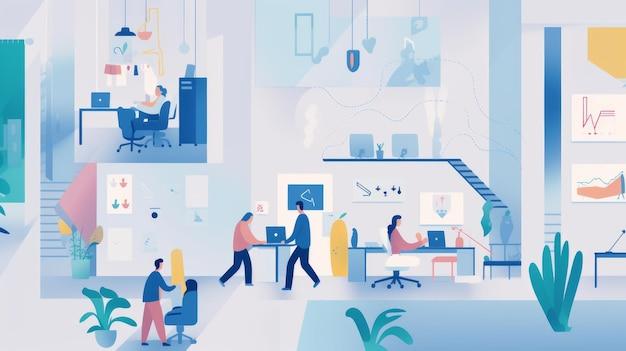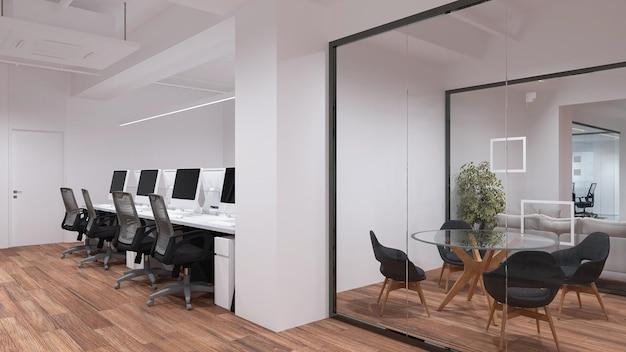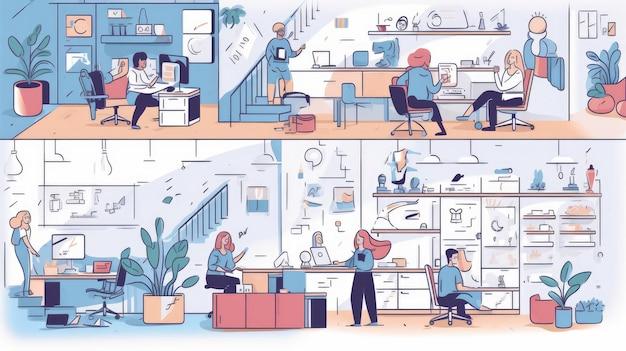Are you looking for ways to increase productivity and engage employees in a diverse workplace? A dynamic workplace may be the answer. But what does it mean to be dynamic? And how do you create a work environment that fosters flexibility and creativity? In this blog post, we’ll explore the concept of a dynamic workplace, its benefits, and some examples of how to be dynamic in your work. We’ll also provide tips on how to create a dynamic work environment and prepare you for working in a fast-paced, diverse workplace. So let’s dive in and discover the world of dynamic work!
The Benefits of a Dynamic Workplace
As our world continues to change rapidly, workplaces need to adapt to keep up. That’s where the concept of a dynamic workplace comes in. But why is a dynamic workplace so beneficial? Let’s break it down.
Increased Productivity
In a dynamic workplace, employees are given the flexibility and tools they need to be productive, no matter where they are. Whether they’re working from home or collaborating in the office, the dynamic workplace model allows for uninterrupted workflows and communication. Plus, with the ability to work when they’re most productive, employees can maximize their output.
Higher Workplace Morale
When employees have the freedom to tailor their work experience to their needs, they’re happier and more motivated. A dynamic workplace fosters a sense of autonomy that can boost morale and reduce burnout. Additionally, by providing a variety of workspaces and technologies, companies can create an environment that employees enjoy working in.
Improved Teamwork
In a traditional workplace, teams are often limited by their physical location and access to tools. With a dynamic workplace, however, teams can collaborate from anywhere and at any time. By breaking down the barriers of a traditional office, a dynamic workplace encourages all employees to contribute their ideas and insights, leading to more creativity and innovation.
Enhanced Work-Life Balance
One of the most significant benefits of a dynamic workplace is the ability to balance work and personal life. With flexible schedules and remote work options, employees can maintain a healthy work-life balance, reducing stress and increasing overall happiness. This can lead to greater loyalty to the company and, consequently, reduced turnover rates.
In summary, a dynamic workplace model offers numerous benefits, including increased productivity, higher morale, improved teamwork, and better work-life balance. By investing in a dynamic workplace, companies can create an environment that fosters creativity, innovation, and happiness for everyone involved.
Dynamic Person
In a dynamic workplace, it’s essential to have dynamic individuals who can meet the demands of a fast-paced environment. Being a dynamic person means having the ability to adapt to new situations, multitask, and work effectively under pressure. In this subsection, we’ll explore some traits of a dynamic person and how they can thrive in a dynamic workplace.
Adaptability
One of the key traits of a dynamic person is adaptability. They can adjust to new situations quickly, whether it’s learning a new skill or taking on a new role. They embrace change and see it as an opportunity to grow instead of a hindrance.
Multitasking
Another trait of a dynamic person is the ability to multitask efficiently. They can juggle multiple tasks and prioritize them accordingly, ensuring that all tasks are completed on time. They can also switch between tasks seamlessly without compromising on quality.
Creativity
Dynamic individuals are also creative problem solvers. They approach problems with an open mind and come up with innovative solutions. They think outside the box and aren’t afraid to take risks.
Positive Attitude
A positive attitude is essential for a dynamic person. They approach challenges with a can-do attitude and see setbacks as opportunities to learn and grow. They are optimistic and inspire those around them to stay motivated.
Continuous Learning
Lastly, a dynamic person is always looking to learn and improve themselves. They seek feedback and strive to develop their skills. They are proactive in seeking new opportunities for growth and development.
In conclusion, being a dynamic person is essential for succeeding in a dynamic workplace. Adaptability, multitasking, creativity, positive attitude, and continuous learning are just some of the traits of a dynamic person. By developing these traits, anyone can thrive in a fast-paced environment and make significant contributions to the organization.
Company Dynamic Meaning
In today’s dynamic workplace, where companies are evolving rapidly, it’s essential to understand the meaning of a “company dynamic”. It’s not just a buzzword that gets thrown around in boardrooms; it’s an essential aspect of any successful business. So, what does it mean?
A Living, Breathing Entity
A company is not just a collection of people working together. It’s a living, breathing entity that has a personality, culture, and purpose. A company dynamic refers to how these elements come together to create a unique and vibrant organization.
The X-Factor
The company dynamic is the “x-factor” that sets successful companies apart from those that struggle. It’s that intangible quality that makes a company great. It’s the personality that shines through in everything the company does, from its products and services to its advertising and marketing.
Culture is Key
At the heart of a company dynamic is its culture. A positive, engaging, and supportive workplace culture can be the key to success. Employees who feel valued and appreciated will work harder, be more productive, and be more likely to stay with the company.
Embracing Change
Part of having a great company dynamic is being able to embrace and adapt to change. In today’s fast-paced business environment, companies that can’t evolve quickly will get left behind. In contrast, companies with a strong company dynamic can pivot quickly and seize opportunities as they arise.
A Winning Formula
In conclusion, the company dynamic is a vital aspect of any successful company. It’s the unique personality, culture, and purpose that sets the company apart from the competition. Companies that can create and maintain a positive company dynamic will have a winning formula for success in today’s dynamic workplace.
Diversity in the Workplace
As the world becomes more globalized, people of various cultures are coming together in the workplace. After all, it’s not uncommon to have a Nigerian accountant, a Canadian salesman, and a Thai marketer under the same roof. With this diversity, you’ll have a range of perspectives and best practices, which is great for problem-solving, creativity, and innovation.
Benefits of Diversity
One of the most significant benefits of diversity in the workplace is that it fosters innovation. People from different backgrounds bring unique insights that could unlock solutions to otherwise persistent challenges. It also promotes the company’s image and reputation as a forward-thinking and inclusive organization, which could attract a wider customer base.
Another advantage of diversity in the workplace is that it’s good for employee morale and engagement. It feels good to know that you work for a company that values inclusivity and equality. And when employees feel valued, they are more likely to be productive and contribute to the organization’s success.
Challenges of Diversity
While there are undeniable benefits of diversity in the workplace, it’s not always roses and sunshine. There are also some challenges associated with it. For one, cultural differences may lead to communication breakdowns, misunderstandings, and even conflict.
Moreover, unconscious bias is still prevalent in many workplaces. Unconscious bias is the act of harboring a prejudice towards someone of a different race, ethnicity, gender, religion, or sexual orientation without even realizing it. Such bias could lead to unequal treatment, favoritism, and exclusion of minority groups.
How to Embrace Diversity in the Workplace
To embrace diversity in the workplace, the following strategies might help;
- Encourage cross-cultural learning and understanding. Consider having diversity training for employees to help them understand the cultural differences that exist and how to mitigate them.
- Avoid stereotypes. Take time to understand each individual’s strengths, values, and preferences. This way, you’ll be able to leverage each person’s strengths and create a more inclusive work environment.
- Promote diversity in hiring. Encourage diversity in job vacancies and in the recruitment process, to ensure that the company attracts employees of varied backgrounds.
All in all, a dynamic workplace that embraces diversity is one that is respectful, inclusive, and equitable. When organizations prioritize diversity and inclusivity, they foster a culture that promotes creativity, innovation, and productivity.
Dynamic Workplace Services
Welcome to the world of dynamic workplace services! In today’s fast-paced world, businesses need to be more adaptable than ever before, and this starts with their workplace. Dynamic workplaces are designed to fit the needs of modern businesses, offering flexible and customizable solutions that can be tailored to each company’s unique requirements.
What Are Dynamic Workplace Services
Dynamic workplace services encompass a range of options that businesses can choose from to create a more flexible and adaptable workplace. These options can include:
- Co-working spaces
- On-demand meeting and conference room rentals
- Virtual offices
- Mail and package handling services
- IT support services

With the rise of remote work and the gig economy, dynamic workplace services have become increasingly popular in recent years. These services offer businesses the flexibility they need to grow and thrive in today’s rapidly changing business landscape.
The Benefits of Dynamic Workplace Services
Dynamic workplace services offer a wide range of benefits for businesses of all sizes. Here are just a few of the advantages they provide:
Increased Flexibility
Dynamic workplace services allow businesses to scale up or down as needed, ensuring that they always have the resources they need to get the job done.
Cost Savings
By only paying for the services they need when they need them, businesses can save money on overhead costs like rent, utilities, and equipment.
Access to Top-Tier Technology and Infrastructure
Dynamic workplace services often come equipped with state-of-the-art technology and infrastructure, allowing businesses to work more efficiently and productively.
Improved Work-Life Balance
With options like co-working spaces and virtual offices, employees can work from anywhere, allowing for a better work-life balance and increased productivity.
Dynamic workplace services offer businesses the flexibility, cost savings, and technology they need to succeed in today’s fast-paced world. Whether you’re a small startup or a multinational corporation, dynamic workplace services can help you create a more adaptable and innovative workplace that can meet the demands of today – and tomorrow.
The Fast-Paced Workplace
No one likes to be slowed down at work. In today’s fast-paced work environment, things are moving faster than ever before. It’s no longer enough to simply keep up with the competition- you have to be one step ahead. Here, we’ll explore what it means to work in a fast-paced workplace and how to survive and thrive in this dynamic environment.
Always on Your Toes
In a fast-paced work environment, you’re always on your toes. You never know what’s coming next, and you have to be ready for anything. This can be both exciting and overwhelming. On one hand, it’s thrilling to be constantly challenged and pushed to your limits. On the other hand, it can be exhausting to always be on high alert.
Time is of the Essence
In a fast-paced work environment, time is of the essence. Every second counts, and there’s no room for wasted time. It’s important to be efficient and productive in everything you do, from answering emails to completing projects. Procrastination is not an option when deadlines are looming.
Multitasking is Key
In a fast-paced work environment, you’ll often find yourself juggling multiple projects and tasks at the same time. Multitasking is key to staying on top of everything. However, it’s important to prioritize your tasks and not let any of them fall through the cracks. One way to do this is to break your day up into smaller, more manageable chunks and focus on one task at a time.
Mistakes Happen
In a fast-paced work environment, mistakes are going to happen. When you’re moving quickly, it’s easy to overlook details or make an error in judgment. The key is to own up to your mistakes and use them as learning opportunities. Don’t beat yourself up over them- instead, figure out what went wrong and how to avoid making the same mistake in the future.
Constant Learning
In a fast-paced work environment, things are always changing. New technologies, new processes, new competitors- it can be hard to keep up. However, this environment also provides opportunities for constant learning and growth. Embrace new challenges and be open to trying new things. The more adaptable and flexible you are, the more successful you’ll be in this dynamic workplace.
Working in a fast-paced environment can be both thrilling and exhausting. It’s important to be efficient, productive, and adaptable in order to succeed. Remember to prioritize your tasks, own up to your mistakes, and embrace new challenges. And most importantly, don’t forget to take a breather every now and then- even the most dynamic workplaces need a moment of rest.
What is a Dynamic Workplace
Are you tired of working in a dull and lifeless office environment with no inspiration or motivation? Then you may want to consider a dynamic workplace. But what is a dynamic workplace, you ask?
Well, it’s not one of those self-proclaimed “cool” workplaces with a pool table, bean bags, and free snacks. Although, those things can be nice too. A dynamic workplace is a work environment that allows employees to be flexible, adaptable, and creative.
It’s All About Flexibility
Dynamic workplaces value flexibility above everything else. Employees are given the freedom to work from anywhere, anytime and are not constrained by strict 9-to-5 schedules. This freedom helps employees to manage their personal and professional lives in a better way, leading to less stress and more productivity.
Adaptable and Agile
In a dynamic workplace, the ability to adapt quickly to changing circumstances is highly valued. The work environment is designed to be agile, allowing employees to pivot and adjust to meet the needs of the business, their clients, and their team members.
Creativity and Innovation
Finally, a dynamic workplace is all about creativity and innovation. It’s an environment that encourages employees to take risks, think outside the box, and experiment with new ideas. The focus is on developing new skills, taking on new challenges, and creating innovative solutions that can help the business to grow and succeed.
In conclusion, a dynamic workplace is more than just a buzzword. It’s a work environment that values flexibility, adaptability, creativity, and innovation. It allows employees to manage their personal and professional lives in a better way, leading to a more fulfilling and productive work experience. So, if you’re tired of the same old boring office routine, it may be time to consider a dynamic workplace.
Examples of Being Dynamic at Work
Let’s face it, work can get monotonous and mundane, but with a little bit of creativity and effort, anyone can be dynamic at their job. Here are a few examples to get you started:
Always Be Willing to Learn
The world is changing fast, and you should too. Take online courses or attend seminars to update your skills and knowledge. Being dynamic means always expanding your horizons, and who knows, the next big thing might just be around the corner.
Switch Up Your Routine
Breaking out of the rut can be as simple as changing your routine. Try sitting in a different spot during meetings, or rearrange your workspace for a fresh perspective. Small changes like these can help you break out of old habits and make room for new ideas.
Collaborate and Communicate
Communication is key in any workplace. To be dynamic, don’t be afraid to speak up and share your ideas. Better yet, collaborate with your team, and work towards a common goal. Brainstorming sessions are an excellent opportunity to generate new ideas that you never would have thought of on your own.
Stay Positive and Energized
No one likes a Debbie Downer. To be dynamic, stay positive, and keep your energy levels high. Smile, engage in lighthearted conversation and take breaks to recharge. A positive attitude can go a long way towards increasing productivity and fostering a dynamic workplace.
Take on New Challenges
Don’t be afraid to tackle new challenges. Being dynamic means taking risks and stepping out of your comfort zone. Whether it’s volunteering for a new project, learning a new skill, or taking on a leadership role, embracing new opportunities can lead to growth and success.
So, there you have it, folks. These are just a few examples of how you can be dynamic at work. Remember, being dynamic doesn’t mean being perfect; it means being flexible, adaptable, and willing to grow. So, go ahead – unleash the dynamism within you!
Creating a Dynamic Work Environment: Tips and Tricks
In today’s work culture, a dynamic work environment is essential to keep the employees motivated and engaged. But how do you create a dynamic work environment without breaking the bank? Here are some simple yet effective tips and tricks:
Embrace Diversity
Diversity is the key to a dynamic work environment. Hire employees from different backgrounds, cultures, and experiences. Embrace their uniqueness and encourage them to express their ideas and perspectives. A diverse team brings diversity in thought and helps in bringing new ideas and concepts to the table.
Create Collaboration Spaces
Gone are the days when employees were confined to their cubicles. Encourage collaboration by creating open workspaces where people can brainstorm, interact, and work together. Break rooms, open seating arrangements, and conference rooms equipped with the latest technology can help in fostering collaboration.
Offer Flexibility
The modern workforce is looking for flexibility. Offer flexible working options like remote working, flexible schedules, or job sharing to promote work-life balance and empower the employees to manage their work time effectively. This can help in reducing stress and improving productivity.
Encourage Learning and Growth
Provide opportunities for your employees to learn and grow. Offer training and development programs to help them acquire new skills and knowledge. Encourage them to attend conferences and seminars to learn about the latest trends and technologies in their industry. This can help in enhancing their skills and improving their performance.
Recognize and Reward
Recognize and reward employees’ efforts and achievements to keep them motivated and engaged. Offer incentives like bonuses, promotions, or perks to acknowledge their contributions to the organization. This can help in building a positive work culture and boosting employee morale.
Creating a dynamic work environment is not an overnight process. It requires a blend of creativity, flexibility, and open-mindedness. By following the tips and tricks mentioned above, companies can create a work environment where employees can thrive, grow, and succeed.
Working in a Dynamic Environment Interview Questions
So, you’ve applied for a job in a dynamic workplace. Congratulations! But before you get too excited, you’ve got to get through the interview process. Here are some interview questions you should expect and some tips on how to answer them.
Question 1: How do you manage competing priorities
This one is pretty straightforward. The interviewer wants to know how you handle multiple tasks and stay organized. It’s important to emphasize your ability to prioritize and manage your time effectively. You can also mention any tools or techniques you use to stay on top of your workload.
Question 2: How do you adapt to change
In a dynamic workplace, change is a constant. The interviewer wants to know how you handle unexpected situations or changes in direction. One good approach is to talk about times you’ve had to think on your feet or adjust your plans quickly. It’s also important to highlight your flexibility and ability to roll with the punches.
Question 3: How do you stay motivated in a fast-paced environment
Working in a dynamic workplace can be stressful and fast-paced. The interviewer wants to know how you stay motivated and energized. You can talk about your ability to focus on the task at hand and your passion for the work you do. It’s also a good idea to mention any self-care techniques you use to manage stress and avoid burnout.
Question 4: How do you handle difficult people or situations
In any workplace, there are bound to be difficult people or challenging situations. In a dynamic workplace, these can be even harder to navigate. The interviewer wants to know how you handle conflict and stay professional under pressure. You can talk about your communication skills and your ability to stay calm and focused. It’s also important to emphasize your willingness to collaborate and find solutions that work for everyone.
Question 5: What experience do you have working in a dynamic environment
This is a pretty straightforward question, but it’s important to be specific. Talk about instances where you’ve demonstrated adaptability, flexibility, or an ability to handle change. Give concrete examples that demonstrate your skills and your ability to work well in a fast-paced environment.
Remember, the key to a successful interview is preparation. Take time to reflect on your past experiences and think about how they might relate to the job you’re applying for. Be confident, but also be willing to listen and learn. If you can demonstrate your ability to adapt, collaborate, and thrive in a dynamic workplace, you’ll be well on your way to landing the job.


